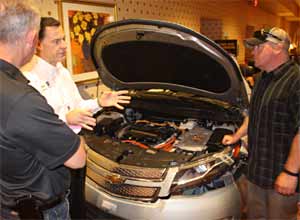
As part of an ongoing push for clean energy, President Obama called earlier this year for one million electric cars to be on U.S. roads by 2015.
What was once thought of as futuristic technology is fast becoming a reality. With it, comes new challenges for responders.
The influx of hybrid electric vehicles (HEVs) and the recent nationwide release of two electric vehicles (EVs) — and the implications for responders — came under the spotlight during a session at Fire-Rescue Med in Las Vegas on Wednesday.
Last summer, the NFPA announced a joint effort with Chevrolet and OnStar to provide electric vehicle safety training for first responders to the scene of an accident, which has resulted in www.evsafetytraining.org.
As part of the program, teams have also toured the country to bring training directly to departments and agencies.
"What we have found is there's a lot of interesting stuff floating around about these vehicles, we've heard interesting stories about what you have to do to make them safe," said George Baker, public policy manager for OnStar.
Baker said the investment, both from the public and private sector, is huge, meaning these new vehicles are here to stay for good.
"It's not like these are going to disappear tomorrow," he said. "But I think what you need to keep in mind is we have always adapted to changing technology in emergency services."
A common misconception concerning the new vehicles, according to Baker, is that they look different to regular cars.
"When it comes to identifying them, some people think they look really different, that they are bubbles, when in reality they look like standard models. The bulk of them are all based on standard vehicles chassis," he said.
Jason Emery, fire service training consultant at the NFPA, went on to outline some of the main response concerns that they have come across — specifically, perception versus reality.
The first, he said, is that high voltage batteries will leak dangerous amounts of fluid if damaged. This is not the case, the session was told, as the batteries are not lead acid, NiMH and Li-lon are dry cell batteries, electrolyte is absorbed in a medium, and only a few drops may be produced if a cell is crushed.
Another concern from many responders is that they risk electrocution by touching an HEV/EV involved in a crash or is submerged.
Again, the reality of the matter is different, with Emery telling the session that the high voltage system is completely isolated from the chassis and that integrated safety systems and basic electrical theory protect occupants and responders.
Another misconception, Emery said, is that it is difficult to disable the HV electrical safety system. In reality, these new vehicles have integrated shutdowns in the event of crash, shutting of the vehicle's ignition will shut down the HV.
In addition, the concern that special equipment is needed for fires in these vehicles is misplaced — attendees at the conference learned that fires in HEVs and EVs are extinguished with standard firefighting procedures.
However, there are some issues responders need to be aware of, with one of the main challenges being unexpected movement of the vehicle.
"You really have to keep in mind that these make no engine noises," Emery said. "You have to be careful. Nowadays, when approaching any scene, you should never approach the vehicle from the front or rear."
The solution? Always ensure the vehicle is shut down and secured from moving, according to Emery. Wheels should be chocked, the emergency brake engaged and the vehicle should be placed in park.
With these vehicles becoming evermore commonplace on roads across the United States, Emery said responders should begin to develop the mindset that vehicles involved in incidents are HEVs or EVs until proven otherwise.
"It's easier to start that way and work your way back," he said. "We need to respect them. There's some stuff in there that can hurt if you're not careful, but we shouldn't see this growth as the end of the world."
By Jamie Thompson / FireRescue1 Senior Editor
| ![]()




